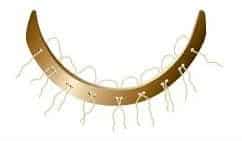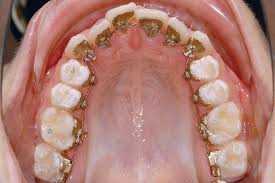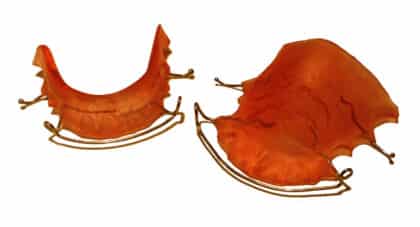What is Orthodontics?
Orthodontics is the first specialty of dentistry concerned with the study and treatment of malocclusions (improper bites) and crooked teeth. Malocclusions may be the result of tooth irregularity, disproportionate jaw relationships, or both. Orthodontists are men and women who finished their initial dental education and training and elected to continue their education to involve the skills and knowledge of orthodontics. It is important to note an extensive malocclusion- such as an underbite, overbite or crossbite can cause a person to have breathing problems (sometimes making a person become a mouth breather which can cause dental concerns), problems chewing properly and even difficulty speaking properly. Orthodontic treatment helps adjust a person’s teeth and sometimes jaw structure for better alignment which leads to better breathing, eating and speaking abilities. There are different types of appliances used for orthodontic treatments such as dental braces, invisalign (clear), retainers, headgear and expansion appliances.
The History of Dental Braces
For comprehensive orthodontic treatment, most commonly, metal wires are inserted into brackets, called Dental Braces. These devices are used to align and straighten teeth and help to position them with regard to a person’s bite, while also working to improve dental health. Braces can either be cosmetic or structural and are often used in conjunction with other orthodontic appliances to help widen the palate or jaws and to otherwise assist in shaping the teeth and jaws.

Scholars and historians claim braces date back to ancient times. Works of studies have been found dating back to 400-300 BC of Hippocrates and Aristotle contemplating ways to straighten teeth and fix various dental concerns. Numerous mummified remains of ancient people have been found with metal bands wrapped around their teeth. Unfortunately, due to lack of evidence, poor preservation of bodies and primitive technologies, very little research was carried on dental braces until the 17th century.
Orthodontics began expanding and developing fully during the 17th, 18th and 19th centuries. In 1728 French dentists, Pierre Fauchard (you remember him, the father of modern dentistry), published the book “The Surgeon Dentists” which includes methods of straightening teeth. Fauchard, in practice, used a device he invented called a Bandeau, a horseshoe shaped piece of iron that helped expand the arch.

In 1819, Delabarre introduced the wire crib. Maynard was the first to employ gum elastics in 1843, but Tucker was the first to cut rubber bands from rubber tubing in 1850. The first article on orthodontics was written by dentist, writer, artist and sculptor Norman Kingsley in 1858 and published his book “Treatise on Oral Deformities” in 1880. The first simple classification system for malocclusions was devised by Edward Angle in the early 20th century. The classification system is still used today as a way for dentists to identify and describe to other practitioners how crooked the patients teeth are, what way to teeth are pointing and how the teeth fit together. Angle also founded the first school and college of orthodontics, organized the American Society of Orthodontia in 1901, which later became the American Association of Orthodontists.
What’s Happening to Your Teeth During Orthodontic Treatment?
Braces move the teeth through a manipulation of force and pressure. Four basic elements are needed in order to help move the teeth. For traditional metal wire braces, those elements are:
- brackets
- bonding material
- arch wire
- ligature elastic (commonly referred to as an O-ring)
The teeth move with the arch wire out pressure on the brackets and teeth. Braces use constant pressure over a length of time to move teeth into the proper or desired positions. This pressure causes the periodontal membrane to stretch on one side and compress on the other. The process loosens the tooth and pushes/pulls it SLOWLY into the desired position, while new bone grows in behind/in front of the tooth as it moves to keep the tooth in its new position. Yes, the jaw bone will regenerate during this whole process, it is called bone remodeling. This is why adjustments are only done every 3-4 months. A tooth will generally move about a millimeter a month, though everyone’s teeth and jaws are different and tooth movement may vary. This is why orthodontic treatment usually takes 2 1/2 to 3 years to complete.
Types of Braces

Traditional Metal Wire Braces are stainless steel, sometimes used in combination with titanium. These are the most common type of braces, as they are usually the least expensive.
Self Ligating Braces are the same as the traditional metal wire braces but do not require the need of elastic ties.
Clear Braces serve as a cosmetic alternative to traditional metal braces by blending in more with the natural color of the teeth, having a less conspicuous or hidden appearance.
Gold-plated Stainless Steel Braces are often employed for patients who have an allergy to nickel (a basic and important component of stainless steel).
Lingual Braces are custom made fixed braces bonded to the back of the teeth making them invisible to other people.
Titanium Braces are just like the stainless steel braces, but are lighter and just as strong.
Progressive, Clear Removable Aligners (such as Invisalign) are generally not used for complex orthodontic cases. These braces are made of a clear, hard plastic and are used to tilt or rotate the tooth without needing to use wires or tightening. Dr. Maggie Smith and Dr. Laura Peles offer Invisalign treatment here at Affiliated Dentists.
There are a few new bracket concepts under investigation and review. Always ask your dentist and orthodontist for their recommendations.
Post-treatment
After braces come off the teeth, orthodontists will typically have the patient move into wearing a retainer. The purpose of a retainer is to keep the teeth from moving back to their original position after the braces are removed. Retainers help to maintain and stabilize the new position of teeth long enough for the supporting structures to permanently reorganize after the active phase of orthodontic therapy. If a patient does not wear their retainer as instructed by their orthodontist, the whole orthodontic treatment may be compromised.

Orthodontics has been around and used in the physical manipulation of our teeth for thousands of years. The devices and treatment appliances have developed and evolved with the rest of technology and civilization over the many years. And new advancements in the field of orthodontics continue to develop.